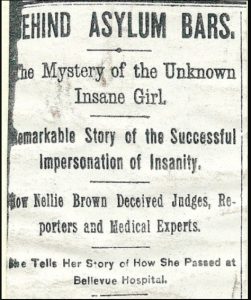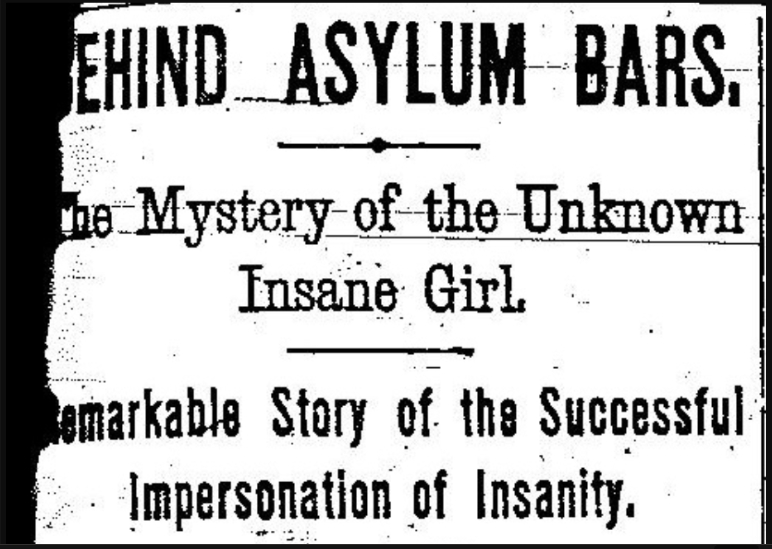
Nellie Bly was a 23-year-old groundbreaking investigative reporter. She went undercover in the Women’s Lunatic Asylum on Blackwell Island. The paper she worked for had been receiving reports about the asylum, and Bly committed herself there to uncover the truth. She prepared herself by practicing how to appear mentally ill. Blackwell Island, notoriously known for its harsh conditions, loomed ominously in her mind. Despite the dangers, Bly was driven to expose the truth.1
Bly convinced the New York World newspaper to allow her to go undercover at the asylum. She faked insanity by practicing in front of a mirror, widening her eyes and staring off into the distance. She studied how mentally ill patients behaved and mimicked those expressions in the mirror. Nellie arrived at a women’s boarding house for impoverished women and pretended to have amnesia while speaking incoherently. Her odd behavior alarmed the other residents, who reported her to the police. She was then examined to determine the extent of her supposed insanity. One doctor accused Bly of using drugs, which shocked her—but it worked. She was sent to Bellevue Hospital, where she spent several days.2
At Bellevue, Bly underwent several examinations and used the undercover name “Nellie Brown.” She was declared demented and in need of care. In a strange way, she felt a sense of accomplishment—she had successfully made it onto the boat bound for Blackwell Island. As she boarded with other women, one of them warned her, “Blackwell Island, an insane place, where you’ll never get out.”3

Once committed to the infamous asylum, Bly stopped pretending to be insane, but her behavior was still dismissed. The staff, already convinced of her condition, ignored her attempts to explain herself. She quickly realized that once a woman was labeled insane, it was nearly impossible to prove otherwise. The more she insisted on her sanity, the more she was seen as delusional. The institution stripped women of their autonomy and silenced their voices. During her time inside, Bly noticed that many other women were clearly not mentally ill, which further supported her belief that countless sane women were being unjustly institutionalized.4
While analyzing the institution, Bly witnessed horrific living conditions. Patients were forced to share freezing, dirty bathwater, ate spoiled food, and wore thin, tattered clothing. Rats roamed the halls. The nurses were cruel—they beat, mocked, and ignored the women, refusing to listen to their claims of sanity. Bly tried to speak up, but doing so only resulted in harsher treatment.5
Bly began to fear that she might never leave Blackwell’s. Even though she was undercover, she started to lose hope. Seeing so many sane women wrongly committed and brutally treated made her question her ability to escape. Still, she remained committed to uncovering the women’s stories inside the asylum.6
After ten days in the asylum, the New York World arranged for a lawyer to secure her release. This showed how easily someone with outside help could escape, while others remained trapped. Once freed, Bly wasted no time. She wrote a gripping exposé detailing the inhumane treatment and unbearable conditions she had witnessed. Her story quickly spread, sparking a wave of public outrage. The backlash forced New York authorities to launch an official investigation. What they uncovered confirmed Bly’s claims: the asylum was plagued by neglect, cruelty, and a desperate need for reform.7

In the end, Bly’s bravery paid off. Her exposé led to real change. The asylum received $1 million in additional funding, and conditions for the patients improved. More importantly, her story sent a powerful message—that one person, willing to speak up, could spark meaningful reform. Bly didn’t just report on the injustices—she lived them, felt them, and shared them with the world. Her legacy helped reshape mental health care and elevated investigative journalism to new heights. It served as a reminder that one bold voice can ignite lasting change.
- Adrienne Kennedy, “Nellie Bly,” in Salem Press Biographical Encyclopedia (Salem Press, April 30, 2023), 1. ↵
- Nellie Bly, Ten Days in a Mad-House; or, Nellie Bly’s Experience on Blackwell’s Island. Feigning Insanity in order to reveal Asylum Horrors (New York: L. Munro, Publisher, 1887), 9. ↵
- Bly, Ten Days in a Mad-House, 48–50. ↵
- Tri Fritz, “World Articles (1887–1888) – Nellie Bly Online,” 25. ↵
- Bly, Ten Days in a Mad-House, 58–79. ↵
- Bly, Ten Days in a Mad-House, 79–87. ↵
- Fritz, “World Articles (1887–1888) – Nellie Bly Online,” 26. ↵




26 comments
Alexa
Very well written
SR Dub
Without Nellie Bly’s courageous work, countless horrors might have continued unchecked. Your paper beautifully captures the significance of her story and offers such a thoughtful and insightful analysis. Truly well done.
Shayde WC
Without Nellie Bly’s courageous work, countless horrors might have continued unchecked. Your paper beautifully captures the significance of her story and offers such a thoughtful and insightful analysis. Truly well done.
Stacy Solis
🔥🔥
Roger Rivas
🔥
Meg Perez
Thank you for sharing this powerful recounting of Nellie Bly’s courageous work. As a mental health professional, I find her story not only historically significant but deeply resonant with many of the themes we still wrestle with today—especially the stigmatization of mental illness, the abuse of power within institutions, and the silencing of vulnerable voices.
What stands out most is how quickly Bly’s identity and autonomy were stripped away once she was labeled “insane.” This speaks to a still-relevant concern: when systems dehumanize individuals, especially those with mental health challenges, it becomes far too easy to ignore their truths. Her realization that many of the women were not mentally ill but were simply poor, foreign, or misunderstood highlights the intersection between mental health, gender, and social inequity.
It’s incredibly encouraging that you’re engaging with this story. It reminds us how advocacy and awareness can lead to real reform. Bly’s work paved the way for trauma-informed care, patient rights, and the need for accountability in psychiatric institutions. Her legacy lives on in every effort we make today to listen to patients, treat them with dignity, and fight for equity in mental health care.
Keep reflecting on stories like this—they not only educate, but they inspire the kind of empathy and critical thinking we need to keep moving forward. Your attention to this history is a step toward becoming someone who helps reshape the system with compassion and integrity.
Meghan
Well written!!
moisess
Easy to read and interesting! Good job !
abraham
fantastic piece of insight. congratulations on getting it published
Savannah
Great job